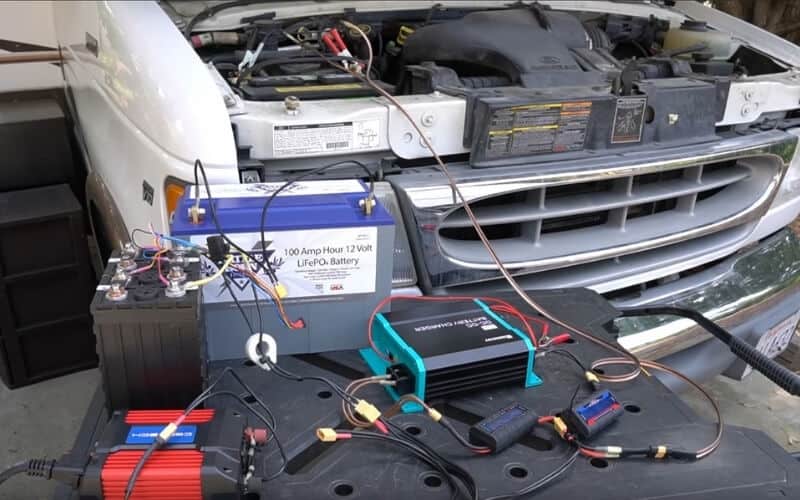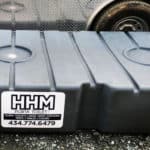The house batteries on an RV serve as the beating heart of the interior electrical system.
The problem is that these camper deep cycle batteries start to experience decreased performance when they drop below 80% of their maximum charge, which is a voltmeter reading of around 10.5.
When these RV house batteries drop below 45%, they can start to suffer damage to the internal lead-acid components.
Considering what a big investment they are, RV house batteries need to be properly maintained by charging them consistently.
When you are at a campground or an RV park this is relatively easy. You simply connect your three-stage battery charger to the shore power system and charge the battery.
It’s when you are boondocking that maintaining RV house battery charge becomes more of an issue.
If you are out in the bush and you need to recharge your RV’s house batteries, you might be wondering if and how to recharge RV batteries from a vehicle?
The good news is that you can indeed recharge an RV’s house battery from a vehicle or the internal engine batter of a motorhome. Though, as you can imagine, the devil is in the details, and a simple mistake here or there could damage the battery, affect the vehicle’s alternator, or even cause bodily harm.
So, let’s take a closer look at how to safely charge an camper trailer battery from a tow vehicle.
This includes a basic understanding of some of the equipment and common questions you might have along the way.
Can You Recharge An RV Battery Using Jumper Cables?
Chances are you have jump-started a car or two in your lifetime, so it might seem like an obvious jump of logic to simply fire up the vehicle or motorhome’s engine and connect jumper cables between its battery and your depleted RV house battery.
Though while jumper cables do deliver some charge, it’s more of a burst charge to get another vehicle’s dead battery to turn over the engine.
If you simply connect jumper cables between the vehicle battery and the house RV battery that needs a charge, the amount of time it takes to recharge the battery will be long and inefficient.
Worse still, you run the risk of damaging the vehicle’s battery or alternator.
A DC To DC Charger Is Needed To Recharge RV House Batteries From A Vehicle
As the term implies a DC to DC charger takes the charge produced by a vehicle and safely transmits it to the depleted RV house battery.
They are available in different amp ratings such as 20 or 50. It essentially makes your vehicle or motorhomes engine a type of DC generator.
If possible, you want to source a 50 amp DC to DC charger as it will put less stress on the vehicle or motorhome’s alternator, while also helping to charge the depleted RV house battery faster.
How To Recharge Your RV Battery From A Tow Vehicle
Here are the steps you need to follow to recharge your camper battery directly through your tow vehicle while.
Step One: Prepare The Connection
The DC to DC charger should run from your RV’s house battery to your vehicle or motorhome’s engine bay.
If there are any concerns about the weather or rain in the upcoming forecast, you want a watertight Anderson-style connector.
Make sure that the connector’s amp rating is the same as the DC to DC charger’s amp rating.
Step Two: Inspect The Line
If this is a pre-owned or otherwise older connection, make sure to give it a thorough inspection to make sure everything is sound and there are no scratches in the protective coating.
If you do find a scratch or exposed wire of any sort, wrap it in insulative rubber to prevent accidental shorts or grounding faults.
Step Three: Connect The Wires
You want the negative wire of the battery connected to the negative terminal of the charger, and the positive to the positive.
Then in the vehicle’s engine bay remove the caps to the battery and connect negative to negative and positive to positive.
Step Four: Start The Vehicle & Run
Let the vehicle run while the charger safely transfers power to the depleted RV house battery.
Once it reaches full charge, remove the black clamp from the RV house battery than from the vehicle or motorhome’s battery.
At that point, you should disconnect the red clamp from your mobile home battery and your car battery. Then reinstall the battery caps on the vehicle’s battery.
Tips For Preserving Battery Life
Deep cycle lead-acid batteries like the ones used in RV hour batteries can last up to 10 years when properly maintained.
This of course calls for keeping them at 45% charge or higher and ideally recharging them when they reach 80% or less to maintain optimum performance.
Ideally, a portable generator that’s rated to produce 40 amps will put less strain on your vehicle’s battery.
It can also be connected to a so-called “Smart Charger” or three-stage charger, which will prevent overcharging excess heat, and possible damage to the battery.
Can I Connect A Vehicle Battery To A Depleted RV House Battery Without Running The Engine?
Technically some charge will transfer between the two batteries. Though the problem here is that you are also depleting the vehicle’s battery, which runs on most of the same principles as your RV’s house deep cycle lead-acid battery.
If you drop your vehicle battery charge below 45%, you could damage it. Worse still, you might deplete the battery so much that it won’t be able to turn over the engine, which leaves you stranded!
Will Solar Or Wind Chargers Help Recharge A Depleted RV Battery?
When charging an RV house battery from a vehicle, it’s best to not have anything else connected to the battery being charged.
The way current travels through these systems can be fickle, and you could end up affecting the stronger connection created by the DC to DC battery charger.
Can I Run Lights & Appliances While Charging The RV Battery From A Vehicle?
While the lights and appliances inside your RV will run when connected to the RV’s house battery, it’s not a good idea to do so.
Not only could it cause electrical issues, but it will also take more time to fully recharge the partially depleted house battery.
Ideally, you want to completely disconnect the depleted RV house battery throughout the charging process.
Should I Drive The Vehicle Or Motorhome After Recharging The RV House Battery?
It is possible, throughout a long recharging session, for the vehicle’s battery to lose some of its own charges while running the DC to DC charger.
Especially if it’s an older battery or the vehicle has an old alternator. If you have a voltmeter, double-check the available voltage of the vehicle’s battery.
If it’s reading anywhere close to 10.5 volts, then you should take it for a 20-minute drive, or at least let the vehicle’s engine run for half an hour or so after disconnecting the DC to DC charger.
Conclusion
It is indeed possible to recharge a depleted RV house battery from a vehicle or motorhome’s engine battery.
Just make sure you have a DC to DC charger, preferably one that is rated for 50 amps.
Then take your time making sure all the connections are solid, and there are no faults in any of the wires.
If possible, disconnect all other lights and appliances inside the RV to help the depleted battery charge quickly.






